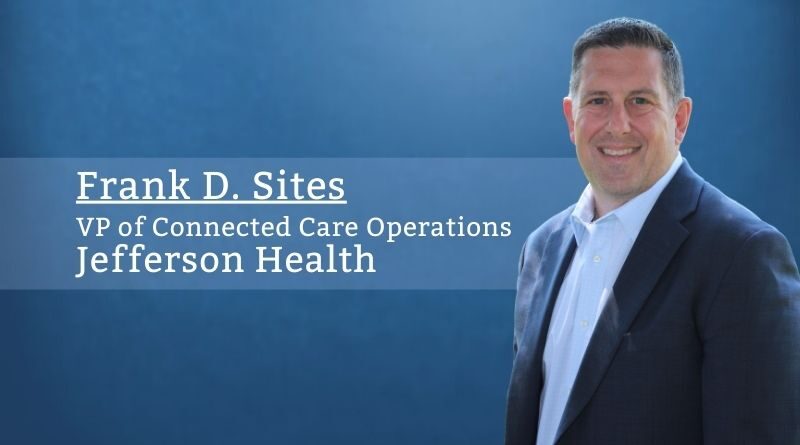Telehealth: An Evolution in Approach and Mindset
By Frank D. Sites, MHA, BSN, RN, VP of Connected Care Operations, Jefferson Health
At Jefferson Health, our vision for a long time has been to blend traditional healthcare with technology to promote and create access. We spoke boldly about designing the future of healthcare and acted by heavily investing in workflow redesign, provider education, and technology. Purchasing and equipping providers with new technologies was only the beginning. Engaging each provider and providing them with the necessary education and workflows supported their eventual adoption of the latest technologies. This approach was key to a successful change in the provider’s mindset. From the onset, we understood that human factor engagement was crucial for providing a practice environment whereby providers would likely adopt the technology, thus leading to patient exposure and adoption of that technology. Success was defined as patient and provider adoption, improved access to care, and an increase in the total number of providers who utilized telehealth regularly in their practice.
In the early days of telehealth adoption, our tagline was “anytime, anywhere” or “care without walls,” which was meant to describe removing barriers to care and our ability to create access to healthcare on the patient’s terms. This concept was born out of an obligation to meet our patients at their convenient place and in a way that was tangible for our patients and families. Now, those tag lines are outdated and telehealth is now simply considered healthcare.
Necessity became the trigger for widespread telehealth utilization for our organization during our Covid-19 pandemic response. Given that the telehealth infrastructure was in place, our organization was able to quickly pivot to stay connected with our patients through the increased deployment. And while this may have been a foreign concept for many organizations that are new to telehealth and for Jefferson Health, this was more about our ability to right size and scale up when needed. Our organization buckets telehealth largely into two categories, scheduled visits with established patients and On-Demand, which serves as a direct-to-consumer 24/7/365 video urgent care model.
Our organization buckets telehealth largely into two categories, scheduled visits with established patients and On-Demand, which serves as a direct-to-consumer 24/7/365 video urgent care model.
In preparation for the “what if” Covid-19 would shut down in person ambulatory clinical practices, we took as disaster management approach in preparing and planning for this worst-case scenario. This took shape through a series of distinct approaches; assessment of platform audio-video capacity and bandwidth; provider and support staff educational readiness, operational access, workflow design, and how to conduct an effective physical examination utilizing telehealth.
Admittedly, the ability to scale up telehealth capacity was envisioned to be when the policymakers, payers, and health care delivery systems would come to an agreement on payment models for this mode of care. Now, seemingly overnight, Jefferson Health was able to scale from a fractional amount of telehealth visits to nearly 90% of all ambulatory volume during the first wave of the pandemic. At the same time, On-Demand services saw a 15-fold increase.
Suddenly, when faced with the prospect of lost revenue, limited access to healthcare, and fears of contracting Covid-19, providers were now more willing to engage their patients using telehealth. Prior to Covid-19, we would spend much of our time debunking the myths of telemedicine, specifically that it was “too hard”, and that telehealth visits were ineffective. Literally overnight, providers were not only able to navigate the system and refine their own workflow processes, but also were able to cultivate their own relationships with their patients through this mode of care.
Years before the pandemic, our organization took a transformative approach to educate and train providers on the proper use of telehealth, including everything they needed to know about regulatory, risk, and compliance considerations as well as how to become facile with the technology itself. More importantly, we trained our providers on conducting an effective telehealth physical examination and developed video modules as part of the providers’ onboarding and competency training. These efforts, we believe, led to more rapid adoption and acceptance from both providers and patients alike.
Often, organizational culture and adoption of technology are met with a tepid response. End-users frequently feel put upon to adopt technology into their workflows while balancing operations and clinical care demands. In a changing culture, we needed to work to make this work for providers in order for patients to be presented with this as a viable option to receive their care.
How should I approach telehealth at my organization?
First, identify what it is that you are looking to solve for. This is a key approach in understanding whether telehealth is the right strategy for your organization. Below are some questions you may want to ask yourself as it pertains to your organizational decision on whether a telehealth strategy is a right fit for you:
- Does telehealth differentiate your organization in the market?
- Does telehealth create additional access for patients independent of location (rural vs. urban)?
- Does telehealth relieve other pressures within your organization, such as space allocation or schedule constraints?
- Do my patients expect telehealth as a matter of convenience?
If you have answered yes to any of the bullets above, your organization most likely will benefit from a telehealth program. While the decision to invest in telehealth is not done so lightly, the ability to implement with a provider and patient experience mindset is crucial for engagement and acceptance. A focused approach to train providers on how to conduct an effective physical exam and connect to their patients in a cohesive engaging manner will bridge most concerns related to any potential technology divides.
Telehealth has evolved and so has our thinking about how we should approach it. No longer should we speak about telehealth in terms of technology but simply as healthcare. As with most change management approaches, flexibility is paramount in any organization’s likelihood for successful adoption.
While the pandemic accelerated the adoption of telehealth, those who choose to engage telehealth more deeply as a solution will be best served by investing wisely in provider education in concert with workflow design initiatives. The likelihood of short-term adoption and long-term acceptance of telehealth into provider practice will largely depend on the providers’ comfort level in caring for the patient using telehealth while incorporating the technology into daily practice.



